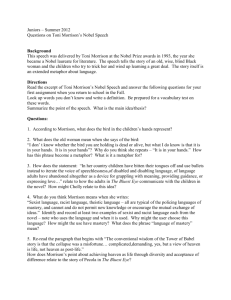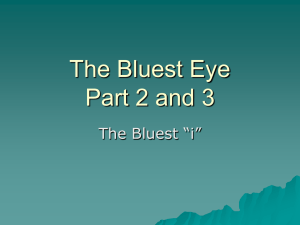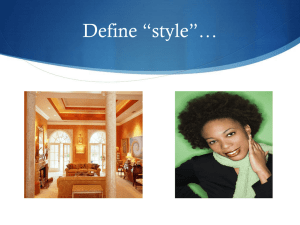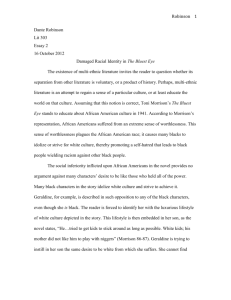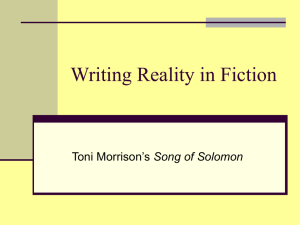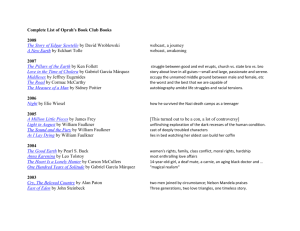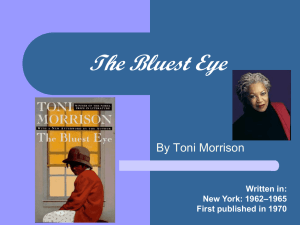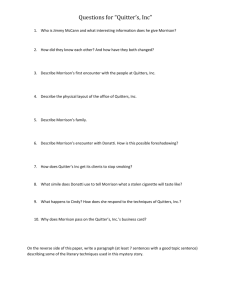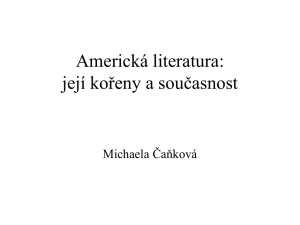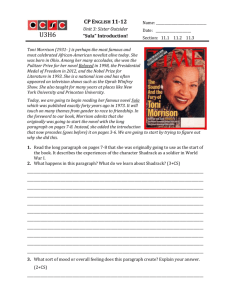The Bluest Eye-NCTE rationale
advertisement
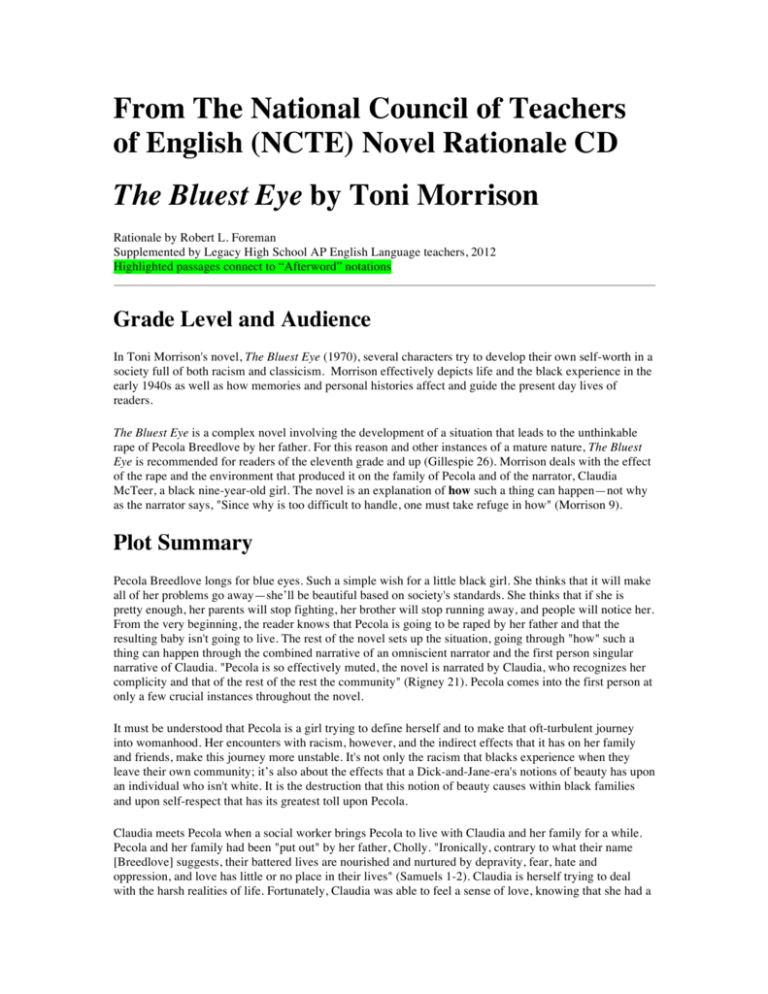
From The National Council of Teachers of English (NCTE) Novel Rationale CD The Bluest Eye by Toni Morrison Rationale by Robert L. Foreman Supplemented by Legacy High School AP English Language teachers, 2012 Highlighted passages connect to “Afterword” notations Grade Level and Audience In Toni Morrison's novel, The Bluest Eye (1970), several characters try to develop their own self-worth in a society full of both racism and classicism. Morrison effectively depicts life and the black experience in the early 1940s as well as how memories and personal histories affect and guide the present day lives of readers. The Bluest Eye is a complex novel involving the development of a situation that leads to the unthinkable rape of Pecola Breedlove by her father. For this reason and other instances of a mature nature, The Bluest Eye is recommended for readers of the eleventh grade and up (Gillespie 26). Morrison deals with the effect of the rape and the environment that produced it on the family of Pecola and of the narrator, Claudia McTeer, a black nine-year-old girl. The novel is an explanation of how such a thing can happen—not why as the narrator says, "Since why is too difficult to handle, one must take refuge in how" (Morrison 9). Plot Summary Pecola Breedlove longs for blue eyes. Such a simple wish for a little black girl. She thinks that it will make all of her problems go away—she’ll be beautiful based on society's standards. She thinks that if she is pretty enough, her parents will stop fighting, her brother will stop running away, and people will notice her. From the very beginning, the reader knows that Pecola is going to be raped by her father and that the resulting baby isn't going to live. The rest of the novel sets up the situation, going through "how" such a thing can happen through the combined narrative of an omniscient narrator and the first person singular narrative of Claudia. "Pecola is so effectively muted, the novel is narrated by Claudia, who recognizes her complicity and that of the rest of the rest the community" (Rigney 21). Pecola comes into the first person at only a few crucial instances throughout the novel. It must be understood that Pecola is a girl trying to define herself and to make that oft-turbulent journey into womanhood. Her encounters with racism, however, and the indirect effects that it has on her family and friends, make this journey more unstable. It's not only the racism that blacks experience when they leave their own community; it’s also about the effects that a Dick-and-Jane-era's notions of beauty has upon an individual who isn't white. It is the destruction that this notion of beauty causes within black families and upon self-respect that has its greatest toll upon Pecola. Claudia meets Pecola when a social worker brings Pecola to live with Claudia and her family for a while. Pecola and her family had been "put out" by her father, Cholly. "Ironically, contrary to what their name [Breedlove] suggests, their battered lives are nourished and nurtured by depravity, fear, hate and oppression, and love has little or no place in their lives" (Samuels 1-2). Claudia is herself trying to deal with the harsh realities of life. Fortunately, Claudia was able to feel a sense of love, knowing that she had a mother who cared for her. She realizes, however, that there is something terribly wrong with the world. When she was younger, she thought it was something that she had brought on herself, much like Pecola, but later she realizes that it has nothing to do with her or any one else in particular; rather, it’s a distortion in society. "As the Breedlove's history is revealed, we discover that their home and lives are by no means simplistic but in fact complex. In turn, we discover the subtle but profound insight into the human condition in general, and black life in particular, that Morrison has carefully woven into the landscape of her fictional world" (Samuels 2). Pecola deals with the same harsh realities that Claudia does, but her father, Cholly, can't deal with his failure as a black male in society and rather than take that anger out on the people who have kept him down, he takes it out on the family he loves. He isn't capable of showing love to his family since he has never known what it feels like to be loved. Cholly is one of those characters "who lose humanity through an excess of freedom, whose drive to disorder is so unfettered that it becomes destructive to self as well as to others" (Rigney 99). "What most wrenches the heart about Pecola in The Bluest Eye is not her poverty and her madness, but her motherlessness" (Rigney 13). Pecola's mother detaches herself from her home life and spends her energy maintaining the home of a white family where she can find pleasure and a sense of order in making a home for their family. Pecola doesn't have the sense of love and caring that Claudia has gained through her mother. Claudia's life was harsh, no doubt, but through all of the harshness, she feels that at least there is someone there who cares enough to be angry with her. Pecola doesn't have this deep sense of love that helps give Claudia's existence meaning. She has feelings of guilt and shame instead, which lead her to believe that there is something she can do, should do to prevent what happens to her. This takes its form in her desire to be beautiful---to have blue eyes like Shirley Temple. The novel isn't really a story about any one individual or even one family, but rather a race of people in a society that doesn't really care. "The 'we' in The Bluest Eye, for example, is wider in implication than the ostensible 'we' of Claudia and her sister, Frieda, for Claudia speaks for a community as a whole, the black community" (Rigney 53). With Morrison, it is important to remember that when she presents the world as distorted and ugly, she does so only that readers can get over the ugliness and see more clearly what is beautiful. "As is true in all of her novels, Morrison juxtaposes the natural order with the failure of human social order" ( Rigney 160). There exists throughout all of Morrison's writing this complex dichotomy. "Pecola exists because of, within, and beyond history, a testament to society's denial of responsibility and its failure to love what it chooses not to see" (Rigney 64). It's by not wanting to see the things that Morrison tries so hard to get readers to understand that they miss the beauty that lies just beyond. Readers must first accept the way things are, for all they're worth, in their entirety, otherwise they fail to see what is valuable in life for fear to look at what is really there. Theoretical Support and Redeeming Values Morrison presents an ugly picture of the world, but there is ugliness in the world. Violence, death, destruction, and rape are things that happen in society. As Laylaw (1990) says in his song, "Freedom of Speech," "Violence is something that happens in society when people are livin’ low and don't know where they can go." It's wonderful to speak of peace and beauty; "I think we all want peace, but it's too much to face and it's too far to reach." Morrison tries to lift her audience up to a level of consciousness about themselves and the world. She wants to tell readers that there is violence in the world; it's nothing new; it's been here for as long as people have been here, but there is also a beauty in the world that goes beyond society's understanding of beauty. According to Piaget (1962), normally-developed teenagers have already begun to reach the formal operations stage of thinking. It is here when people begin to become aware of the world around them, beyond their immediate environment. Teenagers are fully aware the world isn't perfect. They would be interested in someone who can take all of the ugliness they see around them and give it meaning as much as any adult. It is in the portrayal of the ugliness in the world that Morrison tries not only to get readers to see the injustices that they try so hard to ignore, but to see what they're really worth, what meaning, if any, they may have for themselves and the society around us. Adolescents of about the age of twelve have begun to develop a sense of identity (Erikson 1968). But many things can get in the way of their normal development, in which case they can have what is called an "identity crisis," which has actually come to be more the norm than the exception. Pecola in The Bluest Eye, as well as Claudia, are in a state of role confusion. Pecola is consumed by the turmoil, but Claudia manages to overcome her confusion and learn something on the nature of beauty and society. Many young adults are going through crises, maybe one much like Claudia's or even possibly to the degree of Pecola's. These young adults would benefit greatly from a novel like The Bluest Eye. Others fortunate enough not to live in such conditions of lower middle class black families will be able to learn something about the effects of discrimination and how the unconscious perceptions of others can contribute to it. Claudia's attempt to understand the situation of Pecola Breedlove lead her to an understanding that will help her to live productively in society. Even though society may be corrupt, she has developed an emotional independence that allows her to realize that the injustices in the world have little or nothing to do with any personal failure. Havighurst (1953) believes that this independence is a developmental task that society places upon individuals during their adolescence. The discoveries that Claudia makes are relevant to anyone living in today's society and are extremely relevant in the life of a modern adolescent. In Kohlberg's (1969) theory, there are three stages of moral development. Most adolescents are moving from the second stage, conventional morality, into the final stage, post-conventional morality. It's best if the characters or the morals of the story are at or one stage above where the readers are. In the conventional morality stage, adolescents conform blindly to authority and society but in the post-conventional morality, they begin to understand the principles that underlie the conventions of society. Students will find, however, that these principles aren't always based on philosophical notions of right and wrong. Claudia finds that it is somewhere beyond good and evil that things begin to make sense—if they ever do. Society's concept of beauty has nothing to do with morality. In his stages of reading development, Carlsen (1979) suggests that by late adolescence (the last two years of high school), students are interested in reading adult books that deal with the discovery of personal values, significant social issues, unusual human experiences, and the transition into adult life. This could be viewed as an awakening into consciousness about the world. It is at this stage at which readers want to look beyond their immediate surroundings and begin to understand the implications of living within a lager society. All of these needs can be met in The Bluest Eye. Morrison wants nothing more than to provoke a state of greater consciousness in her reader. The value a book such as Morrison's The Bluest Eye has for a mature reader cannot be emphasized enough. Literary Qualities and Summary of Reviews The Bluest Eye is a novel that will prove greatly valuable to teachers and today's young adult when used appropriately in secondary schools. Marvin praises Morrison for her ability as a writer and the quality of her first novel: Morrison is adept in the presentation of character types: cackling, crass black whores; thin brown proper wives whose houses are as clean and barren as their loveless souls; the violent, depraved black, whose antisocial acts culminate a life without love, identity, or human purpose. The dialogue is well paced and rhythmically authentic... This novel by a... considerable talent, has substance... Of particular interest to young adults and social caseworkers. (3806) The marks of a talented writer can be found throughout Morrison's novel, in all of her characters, the portrayal of human misery, and in her masterful use of pungent irony and metaphor. Marvin does feel, however, that the "section depicting the imaginary conversation of the now maddened and schizoid child... weakens the structure and adds little to the story" (3806). Toni Morrison's perspective on the situation, however, is that "it is often necessary for one to lose his mind to keep from going crazy" (Samuels 7). Insanity is no less real than anything else that Morrison portrays. In a review from Choice, Toni Morrison's novel is declared as "a significant addition to the rising tide of black literature" (1018). It is described as "a sympathetic and moving portrayal of human beings caught in the age-old webs of prejudice and hate, and for this alone it deserves to be read." The review in its entirety can't be considered one of the most favorable in the interest of The Bluest Eye, but even this somewhat critical reviewer believes that there is enough of merit to Morrison's novel that it deserves to be read. Other reviewers are more adamant about the quality of Morrison's novel. The most significant and probably the greatest statement in favor of Toni Morrison's work is Frankel's review of the novel. Like the other reviewers, he recognized her ability as a writer. Morrison "reveals herself... as a writer of considerable power and tenderness, someone who can cast back to life the living, bleeding heart of childhood and capture it on paper" (46). Frankel was able to see not only Morrison's ability as a writer who can portray character types and accurately depict life in the 1940s; he realized the significance of her message, the underlying meaning to her story, and the importance of such a message to today's society. "There are many novelists willing to report the ugliness of the world as ugly. The writer who can reveal the beauty and the hope beneath the surface is a writer to seek out and to encourage" (46). This is quite possibly the greatest aspect to Morrison's novel—it’s the beauty and the hope beneath the surface that makes Morrison's novel so invaluable. Donelson and Nilsen explain that "great literature always leaves the reader with something to think about" (64). Toni Morrison certainly gives her readers a lot to think about. As she says, she tried to "shock" her readers into thinking about how the way they see things not only affects how they treat other people, but how they, as a result, confine themselves to a limited view of existence that will eventually limit them. She thought that she was writing about "beauty, miracles and self-images, about the way in which people can hurt each other, about whether or not one is beautiful" (Bakerman 60)—a lot to think about. Again, it's a level of consciousness that Morrison tries to bring her reader to, one that will allow, even coerce, them see the beauty and the hope beneath the surface. Rosenblatt (1983) says that good literature should give the reader "an added awareness that any individual... is the result of interaction with his environment" (251). Above all, Toni Morrison offers this. According to Petitt, "Certain criteria are crucial; unless a novel can fulfill them, it cannot be considered literature" (349). The Bluest Eye fulfills all of Petitt's basic criteria including unity, theme, plot, character development, and dialogue. Originally, Petitt's work was used in establishing that young adult novels can be considered as literature, although she recognized certain limitations that would necessarily have to be imposed upon writers due to the immaturity of their intended readers. The Bluest Eye is certainly a novel that must be considered literature—it’s a novel that is suitable for younger readers. Its intended audience, however, wasn't young adults. Toni Morrison isn't typically considered to be a young adult novelist, therefore she has escaped the limitations that would have been imposed upon her if she had intended on writing specifically for young adults. She was able to write a novel of significant literary quality that was suitable for readers in the eleventh grade and up as Gillespie posits in the Best Books for Senior High Readers and as recommended by the Common Core State Standards, which lists The Bluest Eye as an exemplar text for grades 11-12. Not only was The Bluest Eye in the Best Books for Senior High Readers, but it was also in Steven Arozena's Best Books for Public Libraries. Both of these sources recommend Toni Morrison's novel as valuable literature. These sources list only the best of English literature, the novels that should be in every public library or read by any high school reader. Why The Bluest Eye Should Not Be Banned In a school setting, there are reasons not to use a book for an entire class. Some books are not appropriate for a particular student at a particular time. As Rosenblatt says, young readers need to be "ready" to read advanced texts. They have to have the proper emotional and intellectual level as well as the proper experiences to make a book relevant. The Bluest Eye deals with facets of society that most young readers are ready to deal with. The greatest harm would be to those students who are ready for a book of this nature and didn't have it available to them. According to the National Council of Teachers of English, "Censorship leaves students with an inadequate and distorted picture of the ideas, values, and problems of their culture" (7). With The Bluest Eye, students can explore very relevant themes in society and discuss how they relate to themselves. In her book, The Voices of Toni Morrison, Rigney says that "Morrison's purpose, in both the style and the subject of her histories ...is to shock her reader into political awareness, to challenge not only attitude about African Americans and women, but about patterns of thinking and systems of belief in general" (76). Although some people may object to the situations that Toni Morrison portrays and the way she tries to "shock" her readers, they need to understand her delicate sense of balancing the natural order of the world with the failures of the human social order. There is always a deeper sense of hope for Toni Morrison. She doesn't leave the reader with a pessimistic view of life, just a truer vision into the injustices of the social order. Toni Morrison isn't a pessimist; she’s a beautiful realist. It is this insight into society that students will find invaluable. "Teachers, parents, and administrators should recognize that the essential reason for the existence of the public schools is the students' right to know and become educated citizens" (Burress 1). Toni Morrison offers students an opportunity to think about society and to consider the beauty as well as the ugliness in the world. It's only with such a complete view that they can truly understand or even begin to appreciate what good there is in life. Rosenblatt argues that the student will respond intellectually as a direct result of a book that has relevance in a particular student's life. Considering all of the many things that young readers face in today's society, students are likely to already have a knowledge of if not a first hand experience with many of the ideas that Toni Morrison presents in her novel. For those students for whom this may not be the case, their understanding of such ugliness in such a compassionate manner can only be of benefit to their future dealings with society. If a student is denied the freedom to study a work like Toni Morrison's, they may fail to gain an understanding that will prove invaluable in their future. The National Council of Teachers of English states in The Students' Right to Read that "Ultimately ...the real victims are the students, denied the freedom to explore ideas and pursue truth wherever and however they wish" (7). Notably, Toni Morrison's view of the world is only a point of view and one that isn't likely to be universally accepted. Students don't have to agree, but they will gain more by the pursuit of understanding, which Toni Morrison's novel will force them to do, than they can in the blind submission to one particular point of view. As Reichman conveys in his book on censorship, "Efforts to impose on our school a single political, religious, or moral agenda threatens to foreclose debate and cripple education" (2). Students can't learn effectively unless they're given a complete view of the world. "By suppressing materials containing ideas or themes with which they do not agree, censors produce a sterile conformity and a lack of intellectual and emotional growth in students" (3). As Karolides & Burress have indicated, there are a variety of reasons that people try to censor a book. One such reason that many books are banned is on the basis of obscenity. If this is a valid basis that a book should be banned, then The Bluest Eye will certainly be at least challenged for its use in the public schools. As Reichman posits, "It must be stressed that when characters in fiction use obscenity or profanity, this does not mean the author advocates the use of such language" (33). There are reasons that an author would use profanity in a text, only one of which would be in holding to realism, and it is important that students realize not only the reality of such language, but the reasons that certain people have for using such language. "We must not view in isolation any detail of behavior in our own or any society but must study it against the background of the motives and emotions institutionalized in that culture" (Rosenblatt 152). Another reason that some people may have for wanting to ban The Bluest Eye is the presence of extreme poverty throughout the novel. Both Pecola and Claudia come from lower class settings. Claudia is just a little better off than Pecola, and still she describes cockroaches and poor housing. "Poverty, the way Morrison presents it is a historical fact... But, for Morrison, poverty is also a place, a state of being, a frame of mind, and its effects are catastrophic, taking their toll in human dignity and self respect, finally even sanity" (Rigney 62). Claudia was able to overcome her poverty and find a self-worth that Pecola was never to know by realizing that the problems of the world were not a result of any fault of her own, but simply a fault of the social order. Such an understanding could greatly assist young adults in dealing with problems of their own, especially when these problems are the result of social injustice. Probably the most important reason that The Bluest Eye may be challenged is on the basis of sexual references and/or portrayals of sexual activity. The central action is the rape of Pecola by her father. For many readers, this is probably as objectionable a thing as could be imagined. It wouldn't be surprising if quite a few people had an objection to this element of the story, but readers need to understand what Toni Morrison was trying to do and not judge her on the actions of her characters. In an interview with Tate, Morrison tries to explain what she wanted readers to see and how, through the structure of her novel, she tried to get them to that point: I tell you at the beginning of The Bluest Eye, on the very first page, what happens, but now I want you to go with me and look at this, so when you get to the scene where the father rapes the daughter, which is as awful a thing I suppose as can be imagined, by the time you get there it's almost irrelevant because I want you to look at him [Cholly] and see his love for his daughter and his powerlessness to help her pain. By this time his embrace, the rape, is all the gift he has left. (Rigney 32) Morrison was trying to relieve readers of the shock of such a deed early so that they could see beauty under the surface. She wasn't trying to justify anything, merely to allow readers to look at what happens in a different way, to get them to realize that it isn't so simple as they would like to think. The world isn't black and white as many would like to think. Morrison's novel has objectionable parts, but that is a part of what makes it so valuable. In the defense of anything controversial, readers must not forget the reasons for and the importance of academic freedom in schools. "Academic freedom is generally understood to guarantee the teacher's right to teach and to select classroom materials, and the librarian's right to build an appropriate collection, according to established policies and procedures, without external interference" (Reichman 6). When censorship flourishes, the very ideas of academic freedom are being challenged. References Arozena, Steven. (ed.). (1992). Best books for public libraries: The 10,000 top fiction and nonfiction titles. New Providence, NJ: R.R. Bowker. Bakerman, Jane. (1978). The seams can't show: An interview with Toni Morrison. American Literature Forum, 12, pp. Burress, L., & Jenkinson, E.B. (1982). The students' right to know. Urbana, IL: National Council of Teachers of English. Carlsen, G. R. (1979). Books for the teenage reader. (2nd rev. ed.). New York: Bantam. Donelson, K.L., & Nilsen, A.P. (1989). Literature for today's young adults. Glenview, IL: Scott, Foresman, and Co. Erikson, E. H. (1968). Identity: Youth and crises. New York: Norton. Frankel, Haskel. (1970). In brief [Review of The Bluest Eye]. New York Times Book Review, November, 46. Gillespie, John T. (1991). Best books for Senior High readers. New Providence, NJ: R.R. Booker. Havighurst, R. J. (1953). Human development and education. New York: Longmans, Green Hurston, Zora Neale. (1990). Their eyes were watching god. New York: Perennial Library Jones, Bessie W. (1985). The world of Toni Morrison: Explorations in literary criticism. Dubuque, Iowa: Kendall/Hunt Pub. Co. Karolides, N.J.,& Burress, L.(Eds.). (1985). Celebrating censored books. Racine, WI: Wisconsin Council of Teachers of English. Kohlberg, L. (1969). Stage in the development of moral thought and action. New York: Holt, Rinehart, and Winston. Laylaw and Cold 187UM. (1990). Freedom of speech. [from the music sound track of Pump up the volume]. Universal City, California: MCA Records. Lester Julious. (1984). Do lord remember me. New York: Holt, Rinehart, and Winston. Marvin, P.H. (1970). In brief [review of The Bluest Eye]. Library Journal, 95, 3806. Mckay, Nellie. (1983). An interview with Toni Morrison. Contemporary Literature, 24, 413-429. Morrison, Toni. (1970). The bluest eye. New York: Pocket Books. Morrison, Toni. (19730. Sula. New York: Knopf. National Council of Teachers of English. (1982). The students' right to read. Urbana, IL: Author. Parks, Gordon. (1963). The learning tree. New York: Harper & Row. Petitt, D. (1961). A study of the qualities of literary excellence which characterize selected fiction. (Doctoral Dissertation, University of Minnesota). Dissertation Abstracts. 24, 1889. Piaget, J. (1962). The moral judgement of the child. New York: the Modern Language Association of America. Reichman, Henry. (1988). Censorship and selection - issues and answers for schools. Chicago: American Library Association. Rigney, Barbara Hill. (1991). The voices of Toni Morrison. Columbus, Ohio: Ohio University Press. Rosenblatt, L.M. (1983). Literature as exploration. New York: The Modern Language Association of America. Samuels, Wilfred D. (1990). Toni Morrison. Boston: Twayne Publishers. Walker, Alice. (1973). In love & trouble. New York: Harcourt Brace Jovanovich. Walker, Alice. (1970). The third life of Grange Copeland. New York: Harcourt Brace Jovanovich. Washington, Mary Helen. (1977). Teaching black-eyed Susans: An approach to the study of black women writers. African American Literature Forum, 11, 20-24. Reviews Choice. (1971, October), vol. 8, p. 1018 Library Journal. (1970, November), vol. 95, p. 3806 New York Times Book Review. (1970, November) Sources Which Recommend The Bluest Eye Best Books for Senior High Readers. 1991, 26. Best Books for Public Libraries. 1992, 476. Common Core State Standards for English Language Arts, 2010, 152. Awards Earned By Toni Morrison • • • • • • Modern Language Association of American Common Wealth Award on Literature Sara Lee Corporation Front Runner Award in the Arts Distinguished Writer Award of the American Academy and Institute of Arts and Letters Honorary degrees from Harvard, the University of Pennsylvania, Yale, Dartmouth, Sarah Lawrence, Spelman, and Oberlin. Member of the American Academy Institute of Arts and Letters Presidential Appointee to the National Council on the Arts Source of Award Information Denard, Carolyn C. (1991). Toni Morrison. In Baechler, Lea & Litz, Walton (eds.), Modern American Women Writers. (pp. 317-338) NY: Macmillan.
